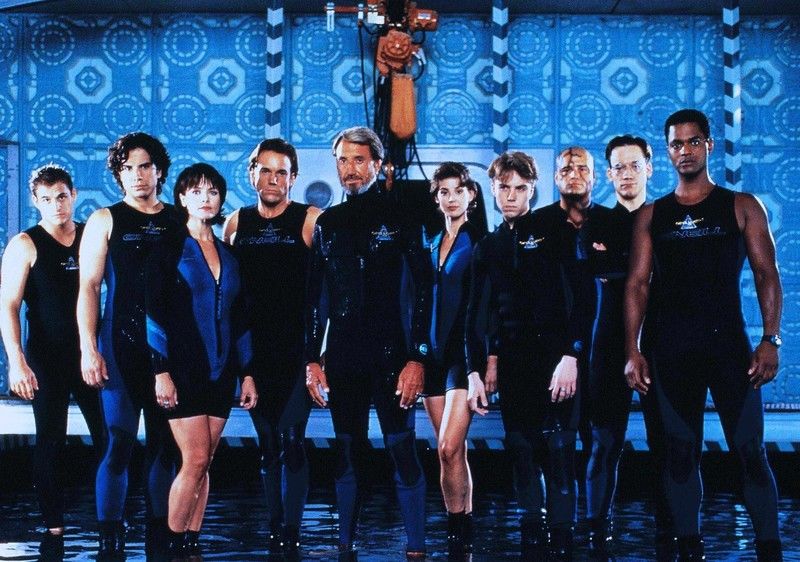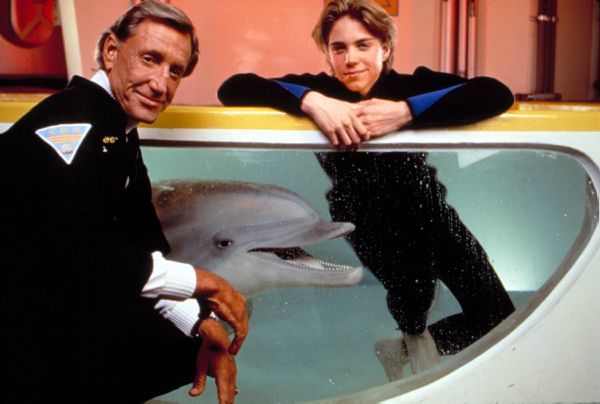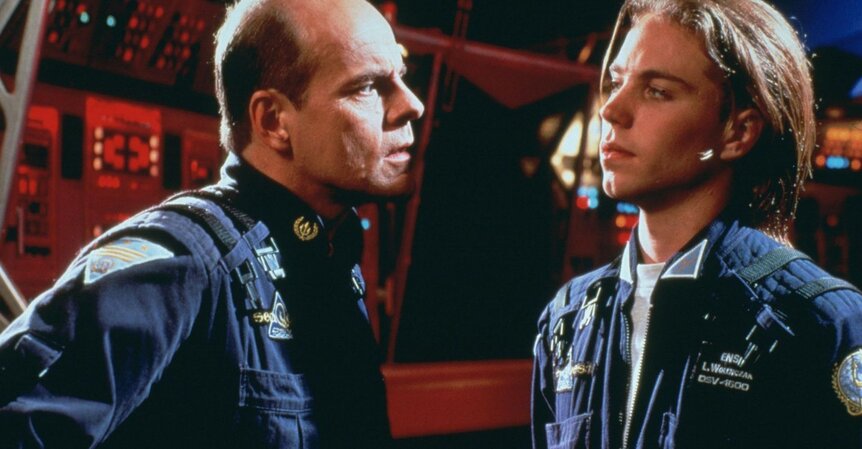Create a free profile to get unlimited access to exclusive videos, sweepstakes, and more!
Why seaQuest DSV is the ultimate '90s sci-fi show

If there's one thing I remember clearly about growing up in the '90s, it's the preponderance of dolphins.
Before I fell in love with the sci-fi series seaQuest DSV, which ran from 1993 to 1996, I knew dolphins were cool mostly because I saw them leaping out of purple oceans of Lisa Frank Trapper Keepers. And remarkably, having a dolphin as a central cast member was not even the most '90s move that seaQuest pulled. The show was a mash-up of nostalgia for baby boomer sci-fi and '90s-style incremental political progressivism. And even though it tried to be more than "Star Trek underwater," that's exactly what it was.
seaQuest debuted amid a huge moment for science fiction on TV. In 1993 alone, seven new network sci-fi shows debuted, which, at the time, was a mother lode. Though we only really care about Deep Space Nine and The X-Files today, 1993 also brought us Space Rangers, Time Trax, and The Adventures of Brisco County Jr. Of all of these shows lost to the sands of time, seaQuest is the most relevant mostly because it was not only an intersection of where sci-fi TV had been at that point, but also a harbinger of where it was going.
To be clear: seaQuest was not a great show. Far from it, but considering that the vast majority of forgotten sci-fi TV is forgotten for a reason, seaQuest stands apart because of its bizarre blend of nostalgia and focus on the future. The show tried to be new but keep old-school sci-fi fans happy, too. For those of us in any fandom today, this all sounds pretty familiar.
Here's the setup: It's the year 2018, and a bunch of Earth's oceans have been colonized. This fact has necessitated the existence of a governmental body called the UEO, short for United Earth Oceans. There are a ton of underwater factions all fighting each other throughout the entire show, and the one thing standing in the way is a super-advanced (read: computer-generated) submarine called the seaQuest. (DSV stands for "deep submergence vehicle," BTW.)
Does this sound like the seaQuest is the starship Enterprise and the UEO is just the Federation from Star Trek? Yes, it does. Throughout its three seasons, you could almost always substitute the underwater setting for the vacuum of space without much changing. The crew of the ship encounters genetically engineered mutants, actual space aliens, a brilliant alien-in-disguise (played by Mark Hamill) time travel, and, yes, William Shatner as a deposed dictator with a mustache.
Apart from the cameos from Hamill and Shatner in guest roles, seaQuest attempted to cash in on some baby boom nostalgia in another very specific way: the lead actor. The captain of the seaQuest was Nathan Bridger, played by Roy Scheider. Now, as an 11-year-old kid watching the show when it was new, Scheider was just some captain actor guy, barely distinguishable in my kid logic from Bruce Boxleitner on Babylon 5.
But to my parents — and an entire demographic of TV viewers at the time — Scheider was the guy from Jaws, the man who says "smile, you son of a bitch" before killing a giant shark. If you're doing a weekly sci-fi show set underwater in 1993, casting the guy who starred in Jaws is probably the smartest move in any sci-fi TV show casting ever. Contemporarily, this would be like casting Tobey Maguire in a TV show about a guy who goes to live with giant spiders or something. And the fact that Steven Spielberg (the guy who made Jaws) was a producer on the show probably had something to do with Scheider's casting.
Still, the show didn't want to rely on just boomers like my parents tuning in. They wanted to suck me in, too. That's why you had Jonathan Brandis and the talking dolphin, Darwin. Let's talk about Brandis first. As Lucas, Brandis was the resident teenage genius on seaQuest, but unlike Wesley Crusher on Star Trek: The Next Generation, Lucas was presented as legitimately cool. He didn't really give a s**t if you understood how smart he was. He had that Leonardo DiCaprio-in-Titanic haircut every white boy had in the '90s, and he wore a lot of flannel. He also was the guy who understood the gizmo that allowed him to talk to a dolphin through a computer.
Now, for those of us who have read the William Gibson short story "Johnny Mnemonic," the idea of a talking dolphin doesn't seem exactly new or novel in a sci-fi context. Plus, one of Douglas Adams' best-known jokes — "So long, and thanks for all the fish" — alluded to dolphins being superintelligent. But, for kids who were 11 in 1993, a dolphin that talked through a Stephen-Hawking-sounding computer was beyond cool; it was the greatest sci-fi concept ever.
In fairness, the connection between the organic world and high-concept sci-fi was one place seaQuest tried to forge new territory. Keep in mind, the craze of every futuristic sci-fi world being a dystopia wasn't really the norm on TV in the early '90s, so the show had more of a can-do-zippy vibe than the whole we're-doomed-to-1984 feeling of contemporary shows. And yet each subsequent season got a little darker than the previous one. In Season 2, we find out that genetically engineered people are basically being enslaved, and oh yeah, this guy who has gills is totally a freak of nature, and the only place for him outside of a Katharine Dunn novel is as part of this crew of misfits.
By the third season, after numerous behind-the-scenes production troubles, including the departure of Roy Scheider, seaQuest pulled a move very similar to what Star Trek: Discovery just did in the Season 2 finale: hit the reset button by sending the ship into the future. For that final season, the show was called seaQuest 2032. Its jump to the future didn't last long — the show was canceled in 1996.
Still, that final season has some interesting developments that seem relevant not only to sci-fi TV of the time but also where we're at today. Replacing Scheider as the new captain was Michael Ironside, a guy who sci-fi fans probably associated with Starship Troopers, where he plays a badass history teacher who becomes a space general with a robot arm. Prior to his turn on seaQuest, Ironside was a go-to sci-fi badass, from Highlander II: The Quickening to Total Recall and, most relevantly, the alien-invasion mini-series V. In short, where Scheider had mainstream appeal because of Jaws, Ironsides had sci-fi nerd cred.
This kind of thing happened in the '90s with other leading actors too; Bruce Boxleitner taking over as the lead in Babylon 5 probably has something to do with people thinking of him as the guy from Tron. And the most famous example of this phenomenon is easily Scott Bakula accepting the role of Captain Archer in Star Trek: Enterprise after being famous on the beloved sci-fi series Quantum Leap.
Sonequa Martin-Green's nerd cred on The Walking Dead didn't hurt audiences accepting her on Star Trek: Discovery. Ditto for Michelle Yeoh's intergenerational crossover appeal. If you want, you can throw Jason Isaacs' fame from the Harry Potter films into the mix, too. The point is a lot of trends we see on new sci-fi shows like Star Trek: Discovery started on seaQuest, or at the very least, in the '90s.
The show was created by Rockne S. O'Bannon, who after the cancellation of seaQuest went on to create Farscape, a show that was unapologetically science fiction and didn't try to split the difference by pandering to the supposed mainstream at all. Creatively, this was a good thing, and yet there is something naively compelling about what seaQuest tried to do: It tried to make an Earth-based sci-fi show into a network TV blockbuster. Baywatch was huge in the '90s, and that took place around water. It's almost as though O'Bannon threw his hands up and said, Let's try to do that but only science fiction.
For me, as a kid though, the most endearing thing about seaQuest was the way it seemed like it could be happening in the oceans at that time. The costumes were sci-fi-ish, yes, but the crew also had awesome baseball caps with the ship's logo on them. And guess what, you could buy those hats in real life. In fifth grade, I used to wear my seaQuest hat to school every single day, and dream of a world featuring underwater aliens and talking dolphins. Of all the nerd swag I've owned in my life, it's the one thing I miss the most.
Sci-fi on TV in the '90s wasn't better than what is out today. But, with a show like seaQuest DSV, it sometimes felt closer to home.




























